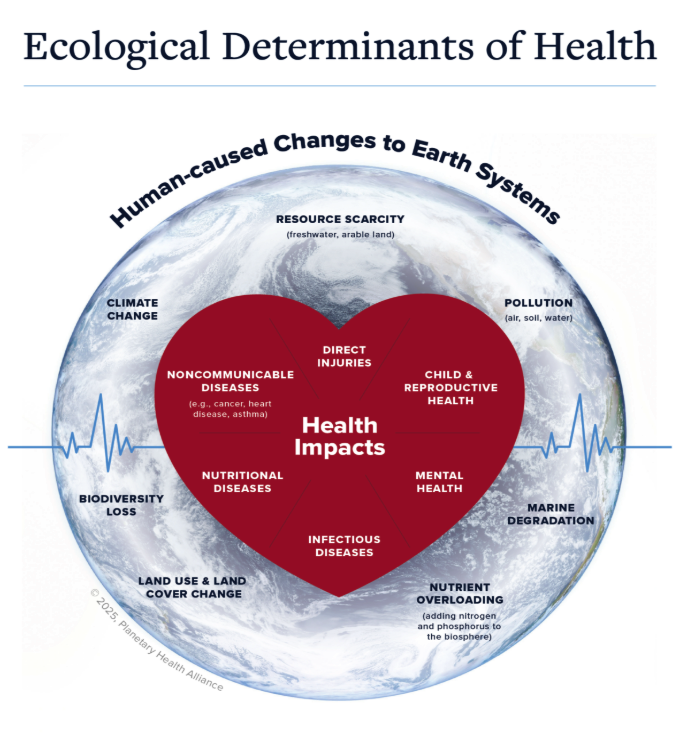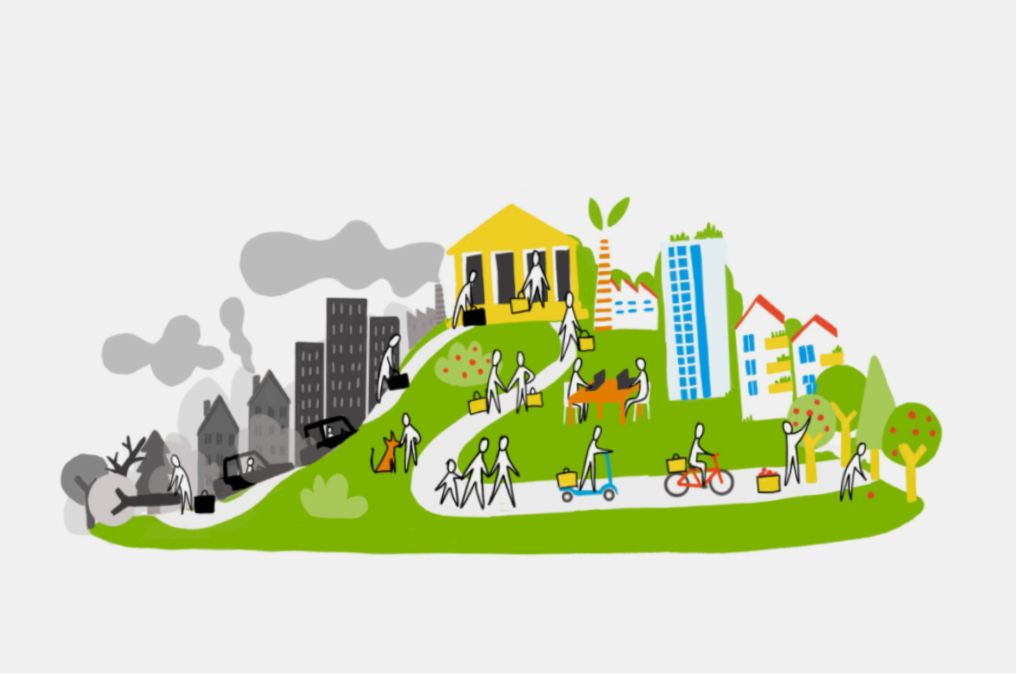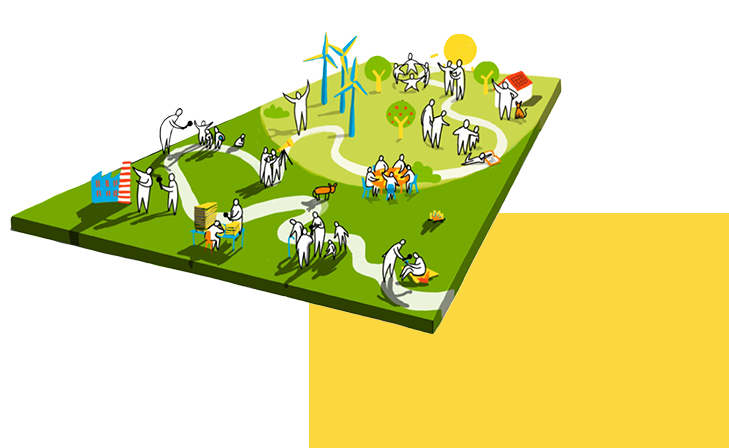Planetary health and the climate
“It is impossible to have healthy people on a sick planet.” Halla Tómasdóttir. President of Iceland. Patron of the Wellbeing Economy Forum 2025.
It’s increasingly clear that the decline in the health of the planet is having a negative impact on human health. The burden of disease is increasingly related to the human-caused changes in earth systems. Extreme weather events such as forest fires, flash flooding, intense hurricanes, and drought, are stark reminders of ecological decline, but they are only the most visible symptoms of a wider ecological decline.
The World Health Organization (WHO) 2023 Compendium on Health and the Environment estimates that approximately 24% of the global burden of disease is now attributable to environmental risk factors.
Climate change, biodiversity loss, global pollution, land use change and deforestation, biophysical changes in the oceans impact air and water quality, food production and nutrition, the spread of infectious disease, and livelihoods, and on our health.


Our current economy prioritizes growth and profit over social and environmental wellbeing, treating damage as “externalities.” Reliance on fossil fuels drives emissions, industrial agriculture fuels deforestation and biodiversity loss, and mining degrades ecosystems. Planned obsolescence and profit-driven finance systems worsen waste and overconsumption. As a result, we are overshooting planetary boundaries, undermining human health today and mortgaging the wellbeing of future generations.
The world
we envision
Our exploitative economic system is not inevitable — we have the power to protect and restore nature. Building a Wellbeing Economy means designing systems around planetary and human health, not endless growth. It would be preventive, regenerative, and circular: businesses aiming for social and ecological good, public policy backing ethical investment, and harmful practices like fossil fuel dependence phased out. This shift would create a self-reinforcing cycle of wellbeing for people and planet, now and for generations to come.
Such an economy would revalue care for people and nature as the true measure of success. It would build resilience against climate and health crises, while ensuring fairness and dignity for all. Most importantly, it would replace short-term extraction with long-term thriving.
Measuring success requires moving beyond GDP toward wellbeing indicators and metrics.
GDP does not consider the impacts of our economic activity (climate change, biodiversity loss, pollution). The central needs of Nature should be measured by the capacity of the economy to cherish, restore, and protect our natural environment and the species we cohabit the planet with.
Wellbeing economies repurpose the economy toward human and ecological wellbeing and away from profit maximization. True cost accounting can help scale down harmful investments (fossil fuels)can help scale down. Transforming finance can scale up purpose oriented social and environmental objectives for example with Norway´s Social Wealth Fund.
WELLBEING ECONOMY EXAMPLES
Transitioning away from fossil-fuels
While many governments have officially recognized the need to transition away from fossil fuels in energy systems, implementation is challenged by the lobbying power and continued pursuit of exploration and expansion by oil and gas companies. Transition is complex, nonetheless it has to happen to avert dangerous levels of global warming. Renewable energy is also needed for sustainable and public transportation systems which are currently reliant on fossil fuels.
Ecosystem restoration
Helps tackle climate change by capturing carbon, repairing degraded lands, and restoring biodiversity. Strengthening natural systems builds resilience to extreme weather, stabilizes water cycles, regenerates soils, and conserves biodiversity. In turn, this supports healthier communities through food security, clean air and water, disease prevention, and job creation.
Circular consumption
Moves beyond the wasteful “take-make-dispose” model by keeping materials in use longer through repair, reuse, remanufacturing, and recycling. The goal is to minimize waste, regenerate nature, and create new value. By redesigning products and systems, we can reverse the damage caused by past production practices and build a more sustainable future.
Food sovereignty and sustainable food systems
These essential to address hunger and nutrition as well as address climate change, and the conservation and regeneration of soil and water quality. Food sovereignty establishes the right of peoples to healthy and culturally appropriate food through ecologically sustainable practices and agroecology principles that would ensure regenerative use of natural resources and ecosystems.
Wellbeing economies look upstream at the systemic causes of climate change and loss of biodiversity in the economic systems and design the economy in a way that stops harm from happening in the first place. More circular and regenerative economies design out waste and pollution, keep products and materials in use longer, and regenerate natural systems. Agroecological approaches to farming and food production including organic farming, agroforestry and permaculture can restore soil quality, and help regenerate ecosystems.
Laws, policies and frameworks for change:
Wellbeing frameworks and budgets
These have been adopted by several national governments, moving beyond GDP to establish broader measures of success, including the health of people, communities, and the environment and working across government agencies to assess, develop, and implement policies that improve wellbeing, with the budgets to support these policies.
True cost accounting
Reveals the impacts of our economic activity on society and on the environment. They are not reflected in the market prices of products and services yet they are often paid for by people or by governments, tasked with cleaning up, fixing and repairing the damage done through our extractive and exploitative economic activity. True cost accounting reveals these impacts. These are not always negative, since positive social and environmental impacts are also undervalued or ignored, for example, the unaccounted value of ecosystem restoration or the care economy, which is propped up by undervalued and unpaid care.
Ecocide law
is among a suite of regulatory and legislative preventive measures to safeguard planetary health with the aim of making acts that lead to extensive damage, mass environmental destruction, or loss of ecosystems a crime. While it is not a new concept there is a growing uptake of national and international legislation to regulate and sanction ecocide. In an Earth 4All 2024 survey of G20 countries, 72% of people surveyed said causing environmental damage should be a criminal offence.
Wellbeing of Future Generations legislation
This introduces long-term thinking in policymaking processes, and reframes how we address these planetary health challenges through intergenerational and holistic perspectives. By applying a future generations lens to the problems of today, we quickly understand that we need to move beyond growth and GDP to wellbeing frameworks supported by the right policies, budgets and incentives.
Wales adopted Wellbeing of Future Generations legislation in 2015, which is now embedded in the Welsh Constitution.
How to talk about a wellbeing economy for environmentalists
Many environmentalists recognize that the crises we face—environmental breakdown, rising conflict, and growing inequality—are rooted in a broken economic system that fails to serve people or the planet. Yet too often, conversations about “the economy” feel distant, confusing, or overly complex. This session is designed for environmental campaigners, anyone working in climate justice or sustainability, or anyone interested in getting involved and deepening their understanding of economic system change + how to build support for an economy in service of people and planet.


